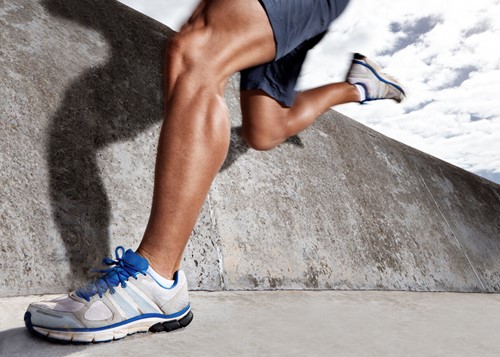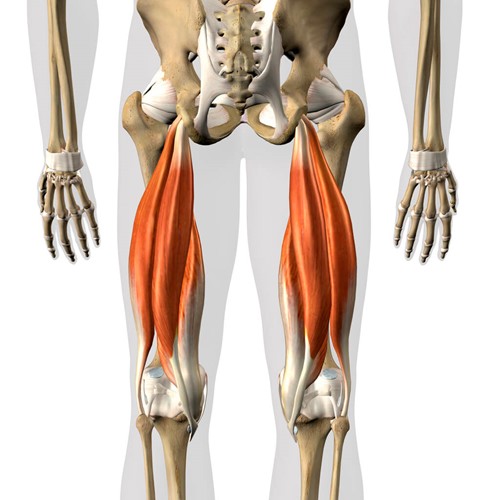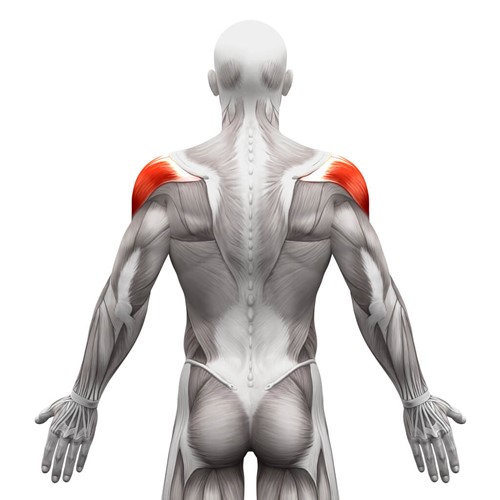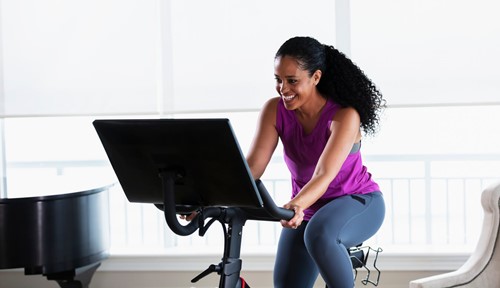

Are you looking to increase your muscle definition through your cycling workouts but unsure how this works exactly?
Don’t panic—you’ve landed in the right place. We cover the fundamentals of muscle tone and how to encourage it through cycling, as well as taking a look at the exercises you can complete to make sure you’re hitting the right areas of the body.
So, what muscles does cycling tone, and how can you maximise your results? Read on to discover everything you need to know.
Contents list:
What is muscle tone?

Before we jump into how to optimise your cycling workouts for muscle tone, it’s good to understand what the phrase ‘tone’ means.
In a nutshell, to tone the muscles is to increase muscle definition.
This is done through a combination of resistance training and cardio/HIIT, which improves body composition and the definition of the muscles by burning excess body fat around them.
Many people confuse ‘muscle tone’ with ‘muscle mass’, otherwise known as muscle hypertrophy. Hypertrophy refers to the size of the muscles, which can only be increased through specific training that involves lifting heavy weights in the range of 8-12 repetitions.
Cycling is great for helping you to achieve a lean and toned physique, especially when paired with other cardio and resistance-based workouts that burn a high number of calories.
However, if you want to increase muscle hypertrophy, you will need to incorporate this form of training into your routine alongside cycling.
Related: The Internet’s Best Cycling Training Plans
What muscles does cycling tone?
Now that we’ve covered the science behind this fitness goal let’s look at the muscle groups cycling tones.
#1 – Thigh muscles

Cycling is great for toning the lower body, particularly the legs. The hamstrings and quadriceps are two of the most targeted muscles during a cycling workout, as they play a huge role in pedalling.
The hamstrings are positioned at the back of your thighs (the posterior) and are involved during the upstroke motion.
On the other hand, the quadriceps are found at the front of your thighs (the anterior). They are heavily targeted during the downstroke.
While the downstroke requires the most effort from any muscle groups involved in cycling, you couldn’t complete the pedalling action without both the hamstrings and quadriceps working together.
Since they’re easily targeted through a range of exercises, it’s a good idea to train these muscles outside of your cycling workouts to promote more definition.
Here are our top exercises for targeting both the hamstrings and the quadriceps:
Related: Top 10 Tips For Long Distance Cycling
#2 – Calf muscles
The muscles in your calves get a great workout when you cycle, during both the upstroke and the downstroke.
They include the soleus and the gastrocnemius, which support the hamstrings and quadriceps in pedalling.
Both the soleus and the gastrocnemius are posterior muscles located at the back of the lower leg. The gastrocnemius is the muscle that gives the calves a lean and defined appearance, with the help of the soleus, which sits beneath it.
Building strength in your calves whilst off your bike can boost your pedalling power and endurance, as well as their overall appearance. It can also prevent injuries such as shin splints, common in cyclists.
Three examples of ways to work on your calves when you’re out of the saddle include:
NOTE: To maximise your leg muscle toning results when completing cycling workouts, be sure to emphasise each stroke. Your feet should move across a circular plane of motion rather than in short bursts to drive the pedals around their axis.
Related: How To Lose Weight By Cycling
#3 – Glutes
One of the most overlooked areas of the body when discussing the muscles that cycling tones are the glutes. There are three muscles in the gluteal group:
- Gluteus maximus
- Gluteus medius
- Gluteus minimus
Many cyclists believe that the glutes are only targeted when they stand up and cycle, but this isn’t the case.
While it’s probably one of the most effective ways of hitting this muscle group, there are other ways you can boost this during a cycling session.
One way is to ensure your seat is in the correct position, often a little higher than you would expect. Doing so allows the hip to travel through a greater range of motion and further engages the glutes.
You can also switch your saddle for one that’s more comfortable. If your seat is uncomfortable, you may subconsciously shift your hips backwards and, therefore, partially disengage the glutes as you’re cycling.
Creating strong glutes when you’re out of the saddle will not only aid your cycling performance, but you’ll find your glutes toning up by the week. The best exercises include:
Related: Cycling: The Surprising Full-Body Muscle Builder
#4 – Arms
Compared to the lower body, the arms are certainly engaged to a lesser extent during a cycling session. However, that’s not to say they don’t play a part in supporting the rest of your body to maximise overall toning results.
The biceps and triceps are activated during a cycling session, as are the secondary muscles within your forearms.
They support your neck, back and core and work to keep your spine in a neutral position, which helps you maintain a good level of balance.
The best way to increase tone in your arms is to incorporate cross-training into your routine. If you enjoy indoor cycling, this becomes easier, especially since you don’t have to focus on steering.
You can easily hop off your bike and get a few sets in before or after your cycling session. Resistance training using free weights or TRX training is the most effective method, and here are a few exercise examples to help you get started:
Related: 7 Ways To Burn More Calories While Cycling
#5 – Shoulders

Depending on the difficulty of the ride, the shoulders (otherwise known as the deltoids) receive a certain level of activation when you cycle.
They work in unison with the biceps, triceps, upper back, and chest to hold the torso in good form.
When you apply force to the handlebars of your bike, these muscles oppose the downward pull of gravity to support your upper body, especially on difficult terrain. This makes rides in hilly areas the best for challenging your upper body and therefore tones muscles in this area.
To eliminate any weak areas in your shoulders and ensure you’re working towards optimum form, you should target this area through resistance training—improving your shoulders’ composition and giving them definition.
You’ll hit your shoulders in the exercises we’ve listed above, but our favourite shoulder-specific exercises include:
Related: 5 Areas Of The Body To Strengthen To Become A Better Cyclist
#6 – Core
Since your core is literally at the centre of your body, it works tirelessly to support multiple areas of the body, including the following:
- Pelvis
- Spine
- Upper & lower back
- Stomach
- Glutes
Cycling requires full activation of the core to support these areas of the body and maintain good form, and it is especially engaged during the more difficult sections of a ride.
The abdominal muscles cannot be toned individually and require a combination of good nutrition and full-body, fat-burning exercises to appear. However certain exercises specifically challenge your core strength.
Here are three of our favourite compound exercises for building this and improving overall body composition alongside cycling:
Related: Top 5 Best Homemade Recovery Meals For Cyclists
Outdoor cycling vs indoor cycling

To increase muscle tone, you need to place your muscles under adequate pressure whilst cycling.
During an outdoor ride, your muscles are challenged from all angles due to the ever-changing conditions, as they work to keep your body steady and your bike moving. This gives outdoor cycling an advantage over indoor cycling, providing the chosen route incorporates a range of terrain.
However, indoor cycling gives you far more control over the resistance level you’re working against, which could technically challenge your muscles further in terms of creating the right conditions for muscle tone to occur.
Indoor cycling also gives you the option of hopping off your bike to complete some weight training, but the same could be said of outdoor cycling if you ride to/from the gym or have free weights at home.
In short, you can achieve a similar level of muscle tone through either of these activities if you stick to a good nutrition plan and optimise your workouts to encourage this.
The important thing to remember is that if you adequately fuel and challenge your muscles, you will see an improvement in their definition.
Specialist cycling insurance from Cycleplan
Whether you’re a hobbyist or an aspiring athlete, you need to protect yourself and your bike through specialist cycling insurance.
This protects you if your bike is lost, damaged or stolen, providing you report it to the police within 24 hours.
At Cycleplan, we provide equipment cover for a range of bikes and accessories up to a total value of £30,000. We also offer additional policies such as public liability and personal accident cover.
Click here to discover how our specialist cycling insurance can help you, and get an instant online quote today.
Please note the information provided on this page should not be taken as advice and has been written as a matter of opinion. For more on insurance cover and policy wording, see our homepage.
